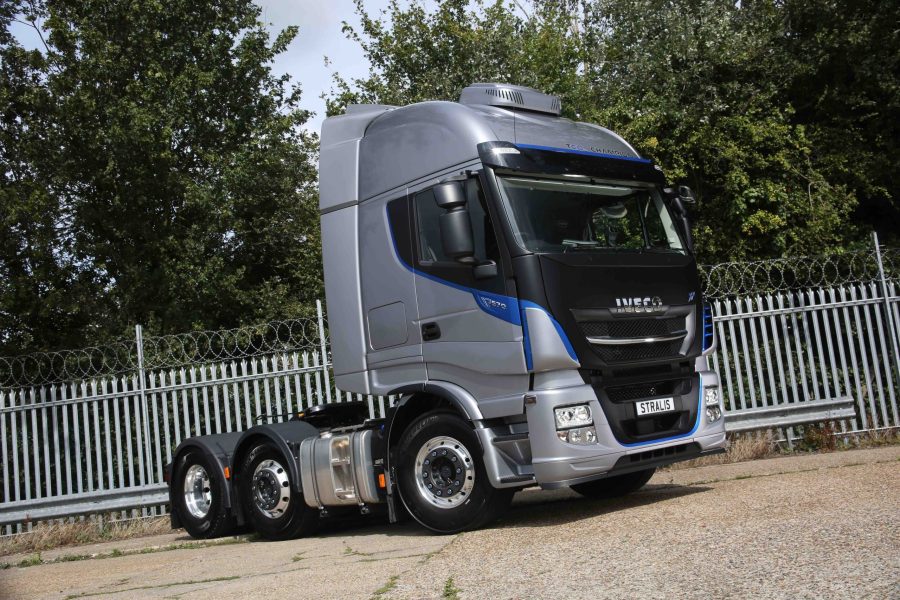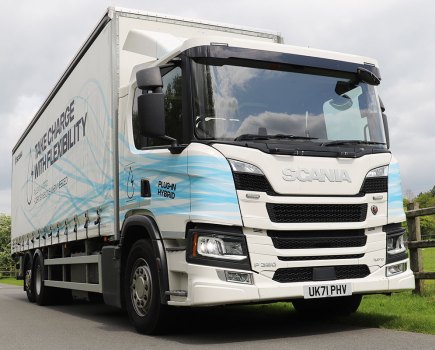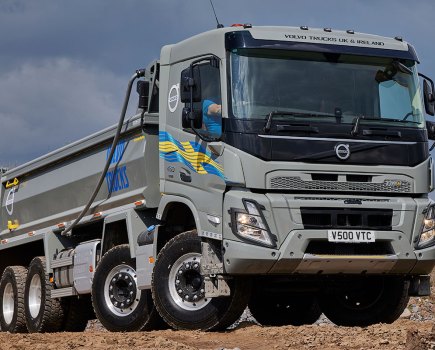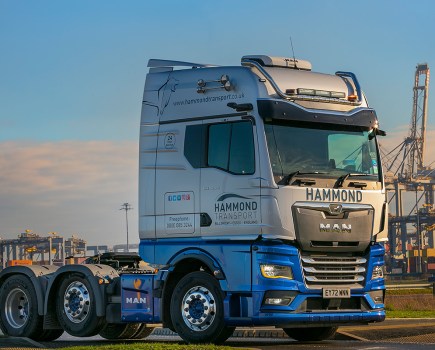Despite having the brand-new S-WAY range to woo customers due imminently, Iveco is still plugging the last knockings of its Stralis models – and for good reasons. The S-WAY won’t be in the UK in right-hand drive form until April 2020 at the earliest, unless there is a change of heart.
So, until then, customers wanting a new truck from the Italian manufacturer are left with the outgoing models. To be fair to it, the company would be naive to just sit back and keep quiet for six months, so making the XP570 available for test driving was understandable. When we were offered a drive of the company’s flagship model, we took it. After all, it’s still worthy of our scrutiny as the new models will retain the same driveline, which was updated as recently as 2016.
The XP570 is the biggest power model in the range, but there are not too many of them on the road. Despite being a flagship-friendly company 25 years ago with its popular and iconic TurboStar model, Iveco has somewhat fallen off the pace when it comes to big-powered, glitzy models aimed at owner-drivers. That mantle has firmly been corned by the Swedes, and to a lesser extent the Dutch.
But that is not a big issue, because Iveco is better concentrating its efforts on the far more lucrative middle-of-the-road, bread-and-butter motors. It’s better to sell volume over flagships.
But while the UK’s roads are not awash with XP570s, the fact the 570 bhp model is made for its more dominant markets – Italy and Spain – means it’s no great shakes for Iveco to offer an RHD version for any UK operators who want one.
Technical overview
The truck we had charge of was an XP570 6×2 mid-lift, though to give it its full designation, it was an AS440S57TX/P XP. It is available with two wheelbase options: 3800 mm and 4000 mm; ours was the former.
The engine is the top power rating of Iveco’s Cursor 13, a 12.9-litre straight-six Euro 6 common-rail engine. Maximum power is delivered at 1900 rpm, which gives a torque rating of 2500 Nm at 1000 rpm.
The transmission is the Iveco 12TX 2620 TD model which has a 12-speed automatic ’box, with two reverse gears. The ratios range from 16.69 in first to 1:1 in top gear. A single dry-plate clutch is used. The rear axle ratio as standard is 1:2.64, although options are available up to 1:3.3.64
The front and mid-lift axles are rated at 7100 kg, while the drive axle is 11,500 kg. One thing where the truck is a real winner is its unladen weight – it tipped the scales at 8040 kg with full tanks of diesel and AdBlue. That is nearly 800 kg lighter than an Scania S500 and 500 kg lighter than a Merc, and is exceptional for a flagship truck with a 570 bhp output.
The truck uses Smart EGR, which means it enables an earlier start of the injection to allow a more efficient combustion. This will help save fuel and works in conjunction with Iveco’s HI-SCR aftertreatment system. The truck also has a smart alternator for fast charging during economic driving, and works with higher loads during downhill driving to exploit the vehicle’s kinetic energy.
The high-roof, twin-bunk Hi-Way full-width cab is the biggest in the Iveco catalogue. This is a good cab, but it is dated now and struggles when compared with some of its rivals. Remember, that does not mean it’s a ‘bad’ cab. It’s not – and it’s certainly one of the best-looking cabs on the market to our eyes. It’s just that competitors have taken more strides, more recently.
On the road
For our test, we took the XP570 for a decent, lengthy drive at nearly full weight. We took in a mix of road types, starting off from Spalding and taking some back roads to join the A17 towards Sleaford and Newark. The it was the A1 south to Peterborough for the A16 back to Spalding.
That gave about a third of the trip on the A1 dual-carriageway, where we could let the Stralis go. As you’d expect with 570 bhp on tap, this truck is no slouch, especially on this road where it’s possible to wind it up to 56 mph very comfortably. And that is just the instance where an engine of this size is valuable: ie, when you have urgent deliveries or long distances to cover, where time saved by superior acceleration is vital.
One you get it to top speed, you can just set the cruise control, sit back and enjoy the drive. That said, the CC is a bit annoying at times and it’s easy to knock it off unwittingly – and there were also times we thought we’d resumed it, only to find out we hadn’t after the speed started to drop.
The dash is OK on an Iveco; it’s neither outstanding nor irritating. All controls are easy to find and we like having the gear selector as buttons on the dash, rather than having a separate ‘gear lever’ as is the case on other marques.
Ups & downs
Away from the fast-flowing dual-carriageway, the Iveco handles impressively well. There were no notable hills of note on our route; a few inclines here and there, but nothing like mile after mile of sustained climbing – and you can easily argue a 460 or 480 bhp Iveco is a much better bet for terrains such as this. But if you do have hills to contend with – for example, if you’re working in the Pennines or in Scotland – or if you simply don’t like slowing down too much for any slight hills you do encounter, then this truck performs admirably.
The engine brake only as two stages, but is actually quite effective. It handles very well and is easy to manoeuvre. The rear vision from the big mirrors is clear, and overall the Stralis is a very nice truck to drive.
The cab is spacious and a pleasant place to work in. We rarely get to overnight in trucks these days, but the bed on the Stralis felt comfortable and it’s certainly big enough. Overall, the cab is a nice environment: it never wows you with high levels of refinement, but nor is it shoddy, shabby or uninviting. Like most truck, once a driver has personalised their cab to their liking, it will become a home from home.
Storage is adequate, but the fact the high-roof cab is sloped at the front limits what useable space there is (though it’s better for aerodynamics). Indeed, this is one of the things that will be addressed with the new S-WAY.
VERDICT
Ivecos are good all-round trucks: they do most things well and they should earn you money. But we’d be lying if we said they were really exciting trucks – though this should really only matter to image-conscious owner-drivers. While they are not meant to be exciting per se, it does no harm whatsoever if they have a level of ‘fun’ that will woo, enthuse or excite drivers. We’ve spoken to many drivers who say: “I don’t mind coming to work if I am driving this…” as they point to their snazzy Scania or Volvo. We’ve never heard someone say that about an Iveco.
Aside from a wow factor, is the XP570 a good truck? Yes, it is. But its flagship potential is limited. It won’t eclipse a Scania S580 or even S540, or a DAF XF530 or a Volvo FH13-540.
Take a look at the numbers though and it’s clear that financially, it has a lot going for it – not least because of its unladen weight. If you get paid by the tonne and you hit 44 tonnes before you max out on volume, then this Stralis is well worth considering. It could earn you a lot of money over a year. Plus, the Stralis will probably have set you back a lot less than certain other heavier trucks.
With the S-WAY due to arrive soon, now might actually be a good time to buy a Stralis. There could be some exceptional deals to be had in the next few months on outgoing Stralis models of all types and engine outputs. If there is stock that needs shifting, then you could actually end up with a decent amount of truck for not a lot of money.
As a brand, Iveco still seems to suffer from a perception problem – and there are lingering concerns about its dealer support. Recently we were talking to an operator of a mixed fleet, which included Stralis, who said they ticked all the boxes in terms of price, driver acceptance and were an all-round “really good motor”, but they had been let down by the dealer support and availability of replacement parts which saw the trucks off the road for extended periods simply waiting on materials.
That is not a good place for the manufacturer to be in; and now it has the S-WAY on the horizon, it’s imperative that Iveco addresses that deficiency. The new S-WAY seems a step up from the Stralis and should start to compete more head-on with other brands. But if the truck is stopped awaiting parts, it’s no use to anyone.
SPECIFICATION
Model: Iveco Stralis XP570 AS440S57TX/P 6×2
• Design GVW/GCW: 26 tonnes / 44 tonnes
• Chassis: 3800 mm wheelbase
• Gearbox: 12TX 2620 TD 12-speed automatic transmission
• Engine: Euro 6 Cursor 13, 12.88-litre, straight six
• Max power: 570 bhp @ 1900 rpm
• Max torque: 2500 Nm @ 1000 rpm
• Cab: Active Space high-roof sleeper






